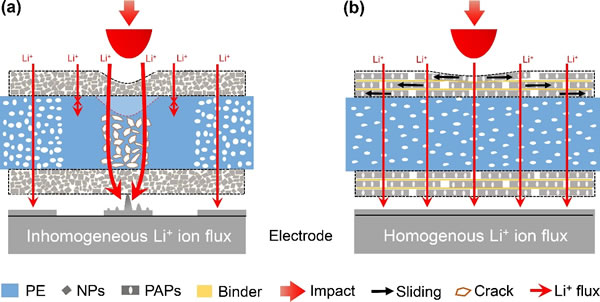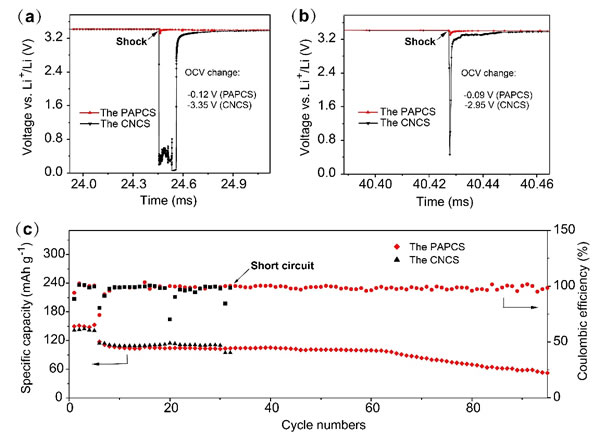Porous polyolefins are widely used as commercial lithium ion battery separators due to their excellent electrochemical stability. As a short-circuit-proof insulation layer between the positive and negative electrodes of the battery, the polyolefin separator greatly affects the safety performance of the battery. The internal porous structure is conducive to the passage of lithium ions in the battery during charging and discharging, but it also results in poor mechanical properties of the separator. Especially when the separator is subjected to local external impact, its internal pore structure will inevitably cause distortion and cause cracking and partial pore closure, thereby affecting the performance and safety of the lithium battery.
Recently, the research team of professors Yao Hongbin, Ni Yong and Yu Shuhong of the University of Science and Technology of China was inspired by the high toughness of nacre and proposed a method to strengthen the impact toughness of polyolefin membrane. The team effectively built the pore structure inside the separator after impact by constructing a nacre-like coating on the surface of the polyethylene separator, thus ensuring a uniform lithium ion flow during battery charging and discharging. Compared with a soft-pack battery using a commercial ceramic separator, a soft-pack battery using an imitation nacre membrane shows a small open-circuit voltage change and better cycle stability and high safety when impacted. The research results were published online in "Advanced Materials" under the title of A Nacre-Inspired Separator Coating for Impact-Tolerant Lithium Batteries on November 6.
At present, ceramic nanoparticle coatings are widely used to improve the thermal stability of polyolefin membranes and the wettability of electrolytes. However, force analysis shows that nanoparticle coatings are difficult to effectively resist the localized external impact, which will inevitably lead The battery has an uneven lithium ion flow during charging and discharging, which causes uneven lithium deposition on the electrode and even leads to the formation of lithium dendrites (see Figure 1a). Based on a deep understanding of the principle of high tenacity of mother-of-pearl in nature, the research team built an ordered structure of "brick and mud" imitating nacre on the surface of polyethylene membrane. When impacted by external force, the mother-of-pearl coating effectively expands the force-bearing area to dissipate the impact stress through the slip of the sheet, thereby effectively protecting the internal pore structure of the separator and maintaining a uniform lithium ion flow inside the battery ( As shown in Figure 1b).
In order to further confirm the effect of the nacre-inspired separator on the safety of commercial batteries, the research team conducted an impact test on soft batteries assembled with two types of separators. Compared with a soft-pack battery using a commercial nanoparticle-coated separator, a soft-pack battery using a mother-of-pearl separator shows a lower instantaneous open-circuit voltage change and faster voltage recovery (Figure 2a, b). The research team also continued to investigate the long-cycle performance of the soft-pack battery after two impacts. The soft-pack battery using the imitation mother-of-pearl coated separator still showed good stability over 80 cycles (Figure 2c). The above research results show that the mother-of-pearl separator has a good protective effect on the battery and can effectively reduce many safety risks.
This work proposes a strategy to build a nacre-like toughened separator, and proves its ability to improve the impact resistance of lithium batteries from theoretical simulations and experimental tests, which will open up new ways for improving the safety of lithium batteries in the future.
The co-first author of the paper is Song Yonghui, a master student in the Department of Applied Chemistry, School of Chemistry and Materials Science, Chinese University of Science and Technology, and Wu Kaijin, a doctoral student in the Department of Modern Mechanics. The research was supported by the Ministry of Science and Technology, the National Natural Science Foundation of China, the Chinese Academy of Sciences and the National Synchrotron Radiation National Laboratory.

Figure 1. Stress analysis of commercial ceramic nanoparticle coated membranes and mother-of-pearl membranes after impact

Figure 2. Comparison of electrochemical performance of batteries assembled using commercial ceramic nanoparticle coated separators and mother-of-pearl separators
Pharmaceutical Material,Melanotan Ii Acetate White Powder,Naphazoline Nitrate White Powder,Hyaluronic Acid White Powder
Henan Tianfu Chemical Co.,Ltd , https://www.tianfuchem.com